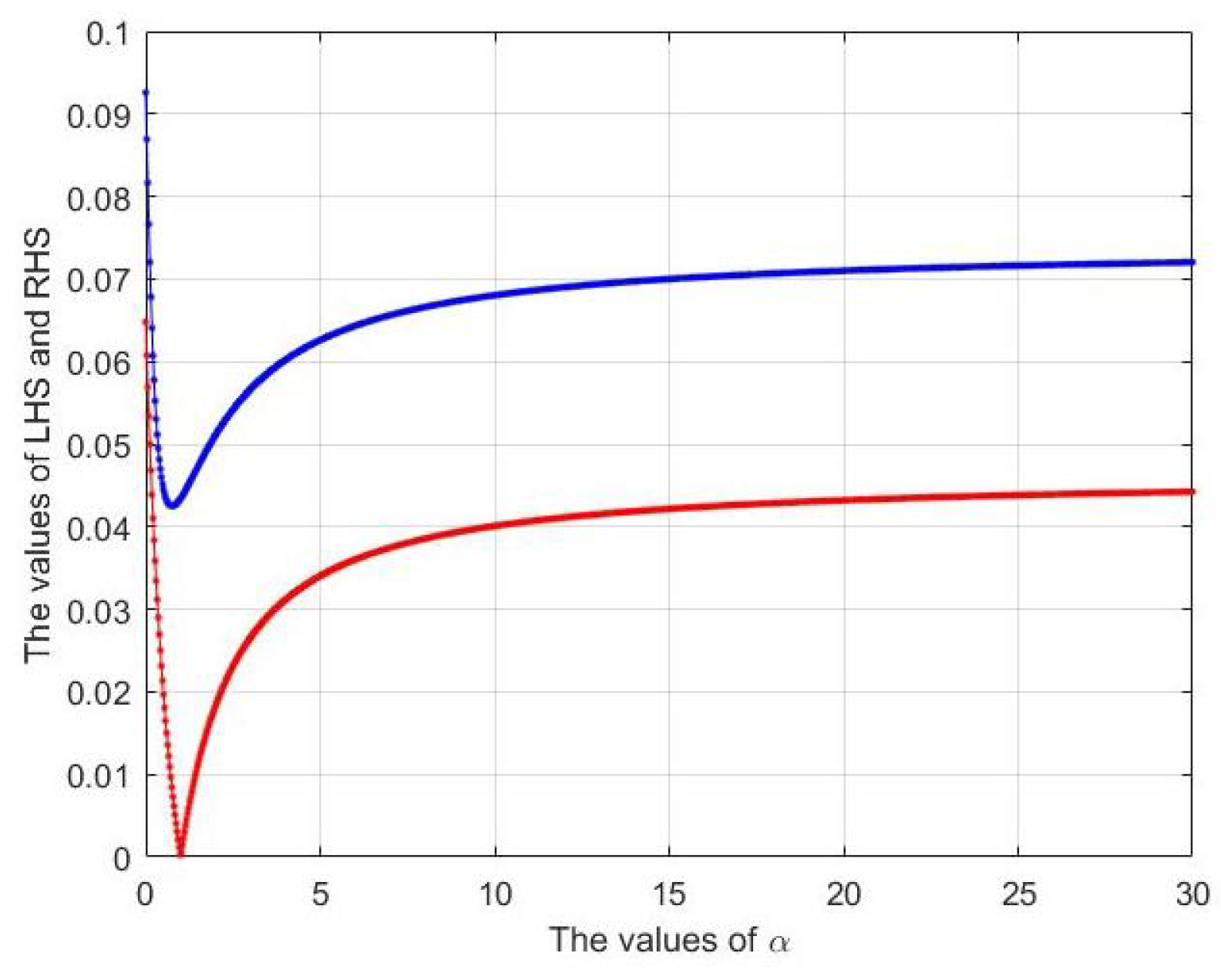Riemann–Liouville Fractional Newton’s Type Inequalities for Differentiable Convex Functions
Abstract
1. Introduction
2. Fractional Integrals and Related Inequalities
3. An Identity
4. Fractional Newton’s Inequalities for Differentiable Convex Functions
5. Fractional Newton Type Inequality for Functions of Bounded Variation
6. Conclusions
Author Contributions
Funding
Data Availability Statement
Acknowledgments
Conflicts of Interest
References
- Sarikaya, M.Z.; Set, E.; Yaldiz, H.; Başak, N. Hermite–Hadamard’s inequalities for fractional integrals and related fractional inequalities. Math. Comput. Model. Dyn. Syst. 2013, 57, 2403–2407. [Google Scholar] [CrossRef]
- Set, E. New inequalities of Ostrowski type for mappings whose derivatives are s-convex in the second sense via fractional integrals. Comput. Math. 2012, 63, 1147–1154. [Google Scholar]
- İşcan, İ.; Wu, S. Hermite–Hadamard type inequalities for harmonically convex functions via fractional integrals. Appl. Math. Comput. 2014, 238, 237–244. [Google Scholar] [CrossRef]
- Sarikaya, M.Z.; Yildrim, H. On Hermite-Hadamard type inequalities for Riemann-Liouville fractional integrals. Miskolc Math. Notes 2016, 17, 1049–1059. [Google Scholar] [CrossRef]
- Sarikaya, M.Z.; Set, E.; Özdemir, M.E. On new inequalities of Simpson’s type for s-convex functions. Comput. Math. Appl. 2010, 60, 2191–2199. [Google Scholar] [CrossRef]
- Peng, C.; Zhou, C.; Du, T.S. Riemann-Liouville fractional Simpson’s inequalities through generalized (m, h1, h2)-preinvexity. Ital. J. Pure Appl. Math. 2017, 38, 345–367. [Google Scholar]
- Chen, J.; Huang, X. Some New Inequalities of Simpson’s Type for s-convex Functions via Fractional Integrals. Filomat 2017, 31, 4989–4997. [Google Scholar] [CrossRef]
- Mubeen, S.; Habibullah, G.M. k-fractional integrals and application. Int. J. Contemp. Math. Sci. 2012, 7, 89–94. [Google Scholar]
- Agarwal, P.; Jleli, M.; Tamor, M. Certain Hermite-Hadamard type inequalities via generalized k-fractional integrals. J. Inequal. Appl. 2017, 2017, 55. [Google Scholar] [CrossRef]
- Farid, G.; Usman, M. Ostrowski type k-fractional integral inequalities for MT-convex and h-convex functions. Nonlinear Funct. Anal. Appl. 2017, 22, 627–639. [Google Scholar]
- Zhang, Y.; Du, T.S.; Wang, H.; Shen, Y.J.; Kashuri, A. Extensions of different type parameterized inequalities for generalized (m, h)-preinvex mappings via k-fractional integrals. J. Inequal. Appl. 2018, 2018, 49. [Google Scholar] [CrossRef] [PubMed]
- Sarikaya, M.Z.; Ertugral, F. On the generalized Hermite-Hadamard inequalities. Ann. Univ. Craiova Math. 2020, 47, 193–213. [Google Scholar]
- Zhao, D.; Ali, M.A.; Kashuri, A.; Budak, H. Generalized fractional integral inequalities of Hermite–Hadamard type for harmonically convex functions. Adv. Differ. Equ. 2020, 2020, 137. [Google Scholar] [CrossRef]
- Budak, H.; Hezenci, F.; Kara, H. On parametrized inequalities of Ostrowski and Simpson type for convex functions via generalized fractional integral. Math. Methods Appl. Sci. 2021, 44, 12522–12536. [Google Scholar] [CrossRef]
- Awan, M.U.; Talib, S.; Chu, Y.M.; Noor, M.A.; Noor, K.I. Some new refinements of Hermite–Hadamard-type inequalities involving-Riemann–Liouville fractional integrals and applications. Math. Probl. Eng. 2020, 2020, 3051920. [Google Scholar] [CrossRef]
- Farid, G.; Rehman, A.U.; Zahra, M. On Hadamard inequalities for k-fractional integrals. Nonlinear Funct. Anal. Appl. 2016, 21, 463–478. [Google Scholar]
- Khan, M.A.; Iqbal, A.; Suleman, M.; Chu, Y.M. Hermite–Hadamard type inequalities for fractional integrals via Green’s function. J. Inequal. Appl. 2018, 2018, 161. [Google Scholar] [CrossRef]
- Khan, M.A.; Ali, T.; Dragomir, S.S.; Sarikaya, M.Z. Hermite–Hadamard type inequalities for conformable fractional integrals. Matemáticas 2018, 112, 1033–1048. [Google Scholar] [CrossRef]
- Set, E.; Choi, J.; Gözpinar, A. Hermite-Hadamard type inequalities for the generalized k-fractional integral operators. J. Inequal. Appl. 2017, 2017, 206. [Google Scholar] [CrossRef][Green Version]
- Tunc, M. On new inequalities for h-convex functions via Riemann-Liouville fractional integration. Filomat 2013, 27, 559–565. [Google Scholar] [CrossRef]
- Zhao, D.; Ali, M.A.; Kashuri, A.; Budak, H.; Sarikaya, M.Z. Hermite–Hadamard-type inequalities for the interval-valued approximately h-convex functions via generalized fractional integrals. J. Inequal. Appl. 2020, 2020, 222. [Google Scholar] [CrossRef]
- Dragomir, S.S. On the Ostrowskiís integral inequality for mappings with bounded variation and applications. Math. Inequal. Appl. 2001, 4, 59–66. [Google Scholar]
- Dragomir, S.S.; Agarwal, R.P.; Cerone, P. On Simpson’s inequality and applications. J. Inequal. Appl. 2000, 5, 533–579. [Google Scholar] [CrossRef]
- Dragomir, S.S. On Simpson’s quadrature formula for mappings of bounded variation and applications. Tamkang J. Math. 1999, 30, 53–58. [Google Scholar] [CrossRef]
- Alomari, M.W. A companion of the generalized trapezoid inequality and applications. J. Math. Appl. 2013, 36, 5–15. [Google Scholar]
- Dragomir, S.S. On trapezoid quadrature formula and applications. Kragujevac J. Math. 2001, 23, 25–36. [Google Scholar]
- Dragomir, S.S. On the midpoint quadrature formula for mappings with bounded variation and applications. Kragujevac J. Math. 2000, 22, 13–19. [Google Scholar]
- Gorenflo, R.; Mainardi, F. Fractional Calculus: Integral and Differential Equations of Fractional Order; Springer: Berlin/Heidelberg, Germany, 1997. [Google Scholar]
- Kilbas, A.A.; Srivastava, H.M.; Trujillo, J.J. Theory and Applications of Fractional Differential Equations; Elsevier: Amsterdam, The Netherlands, 2006. [Google Scholar]
- Pečarić, J.E.; Proschan, F.; Tong, Y.L. Convex Functions, Partial Orderings and Statistical Applications; Academic Press: Boston, MA, USA, 1992. [Google Scholar]
- Alomari, M.W. A companion of Dragomir’s generalization of Ostrowski’s inequality and applications in numerical integration. Ukranianian Math. J. 2012, 64, 435–450. [Google Scholar] [CrossRef]

Publisher’s Note: MDPI stays neutral with regard to jurisdictional claims in published maps and institutional affiliations. |
© 2022 by the authors. Licensee MDPI, Basel, Switzerland. This article is an open access article distributed under the terms and conditions of the Creative Commons Attribution (CC BY) license (https://creativecommons.org/licenses/by/4.0/).
Share and Cite
Sitthiwirattham, T.; Nonlaopon, K.; Ali, M.A.; Budak, H. Riemann–Liouville Fractional Newton’s Type Inequalities for Differentiable Convex Functions. Fractal Fract. 2022, 6, 175. https://doi.org/10.3390/fractalfract6030175
Sitthiwirattham T, Nonlaopon K, Ali MA, Budak H. Riemann–Liouville Fractional Newton’s Type Inequalities for Differentiable Convex Functions. Fractal and Fractional. 2022; 6(3):175. https://doi.org/10.3390/fractalfract6030175
Chicago/Turabian StyleSitthiwirattham, Thanin, Kamsing Nonlaopon, Muhammad Aamir Ali, and Hüseyin Budak. 2022. "Riemann–Liouville Fractional Newton’s Type Inequalities for Differentiable Convex Functions" Fractal and Fractional 6, no. 3: 175. https://doi.org/10.3390/fractalfract6030175
APA StyleSitthiwirattham, T., Nonlaopon, K., Ali, M. A., & Budak, H. (2022). Riemann–Liouville Fractional Newton’s Type Inequalities for Differentiable Convex Functions. Fractal and Fractional, 6(3), 175. https://doi.org/10.3390/fractalfract6030175








